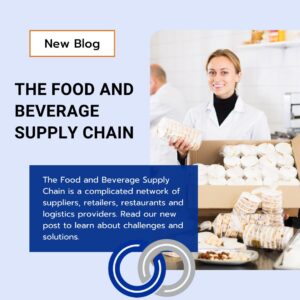 The food and beverage industry is a massive global network that keeps billions of people fed and hydrated every day. Behind the scenes, however, lies a complex supply chain that faces many hurdles and myriad challenges. From farm to fork, these challenges can impact the quality, safety, and availability of the products we consume every day across the globe. In this blog, we will explore some of the significant challenges faced by the food and beverage supply chain and discuss how industry stakeholders are not only addressing them but flourishing in spite of them.
The food and beverage industry is a massive global network that keeps billions of people fed and hydrated every day. Behind the scenes, however, lies a complex supply chain that faces many hurdles and myriad challenges. From farm to fork, these challenges can impact the quality, safety, and availability of the products we consume every day across the globe. In this blog, we will explore some of the significant challenges faced by the food and beverage supply chain and discuss how industry stakeholders are not only addressing them but flourishing in spite of them.
Table of Contents
- What is the Food and Beverage Supply Chain?
- Why is the Food Supply Chain Important?
- What are the Stages of the Food Supply Chain?
- Seasonal Variability and Demand Fluctuations
- Quality Control and Food Safety
- Supply Chain Transparency
- Supply Chain Disruptions
- Rising Costs and Sustainability
- E-commerce and Last-Mile Delivery
- Labor Shortages & Workforce Management
- The Impact of Global Trade Tariffs
What is the Food and Beverage Supply Chain?
The food and beverage supply chain refers to the entire process of producing, processing, distributing, and delivering food and beverages to consumers. It includes every step from farming and manufacturing to packaging, storage, transportation, wholesale, retail, and finally, consumption. The network involves numerous stakeholders such as farmers, processors, distributors, retailers, and foodservice providers, all working together to ensure products are safe, fresh, and readily available.
This complex system relies heavily on precise coordination, regulatory compliance, technology integration (like EDI and supply chain analytics), and increasingly, transparent communication with consumers.
Why is the Food Supply Chain Important?
The food supply chain is crucial because it guarantees the consistent availability of safe, nutritious, and affordable food to populations around the world. Without an efficient and resilient supply chain, food shortages, spoilage, safety risks, and significant price inflation can occur.
A robust food supply chain also supports:
-
Public health by ensuring food safety standards are met.
-
Economic stability by providing jobs across agriculture, transportation, manufacturing, and retail sectors.
-
Global trade by connecting producers and consumers across countries.
-
Sustainability initiatives by driving eco-friendly practices in sourcing, production, and logistics.
The effectiveness of the food supply chain directly impacts social well-being, economic vitality, and environmental health.
What are the Stages of the Food Supply Chain?
The food supply chain can be broadly divided into the following key stages:
-
Production:
Farming, fishing, and livestock raising form the first step. This includes the cultivation and harvesting of raw food materials. -
Processing and Manufacturing:
Raw food products are processed into consumable goods through washing, cutting, packaging, and sometimes transforming them into new products (like milk into cheese). -
Storage and Distribution:
Food products are stored (often in temperature-controlled environments) and transported to distribution centers or retailers. Efficient logistics are vital to preserve freshness and prevent spoilage. -
Retail and Foodservice:
Products reach consumers through grocery stores, supermarkets, online marketplaces, or foodservice outlets like restaurants and cafeterias. -
Consumption:
Finally, the food and beverages are consumed by end-users — households, businesses, or institutions.
Each stage of the supply chain must be carefully managed to maintain product integrity, ensure safety, and meet consumer expectations for quality and transparency.
Eight Challenges & Solutions
1. Seasonal Variability and Demand Fluctuations
One of the most fundamental challenges in the food and beverage supply chain is dealing with seasonal variations in production and demand. Agricultural products, such as fruits and vegetables, are highly seasonal. This can create issues in maintaining a consistent supply throughout the year, leading to price fluctuations, potential shortages and unstable cash flow.
Solution: Manufacturers and retailers in the food supply chain are increasingly investing in technologies like cold storage and refrigerated transport to extend the shelf life of perishable goods. Additionally, forecasting tools and data analytics help in predicting demand fluctuations more accurately. From an EDI standpoint, organizations must determine how much seasonal business is worth the cost of onboarding via EDI. For example, if the seasonal business will add $20,000 revenue and the cost to onboard via EDI is $5,000, then the net gain is $15,000. In many cases, this will be well worth onboarding to EDI. There are other considerations such as production costs, shipping, etc. and every case will be different. Data analytics tools (like Syncrofy) can further help to break down the total cost of business from order to cash or procure to pay.
2. Quality Control and Food Safety
Ensuring the quality and safety of food and beverages is paramount in food and beverage logistics. Contaminated or adulterated products can lead to health crises and damage a company’s reputation. Stringent regulations exist to maintain safety standards, but compliance is often challenging, particularly in global supply chains.
Solution: Companies are implementing advanced quality control systems, using blockchain technology for traceability, and engaging in rigorous supplier audits to enhance food safety. By utilizing blockchain and other integration technologies, companies can securely and transparently track the entire supply chain, from farm to table, providing consumers with peace of mind and the ability to trace the origins of their food. Collaboration with regulatory bodies is also crucial for staying updated with changing regulations.
3. Supply Chain Transparency
Consumers today demand more transparency about the origins of their food and beverage products. This transparency encompasses not only where the products come from but also how they are produced, including ethical considerations and sustainability.
Solution: Brands are leveraging technology like blockchain and QR codes to provide consumers with detailed information about the products they purchase, from the farm or factory to the store. Reference this resource about how blockchain technology is revolutionizing the supply chain, particularly with transparency.
4. Supply Chain Disruptions
Natural disasters, political instability, and global health crises like the COVID-19 pandemic can disrupt the food and beverage supply chain. These disruptions can lead to shortages, price spikes, and supply chain inefficiencies. And the when the dust settles, you’re left with excess inventory which directly affects your bottom line.
Solution: Companies are diversifying their supplier base, investing in risk assessment and management, and implementing business continuity plans to ensure the resilience of their supply chains. In addition, due to lessons learned from the recent disruptions (port traffic and the pandemic) companies are starting to return to JIT inventory management strategies.
5. Rising Costs and Sustainability
The cost of production, storage, and transportation is on the rise, driven by factors like fuel prices and increased environmental regulations. Additionally, there is growing pressure on the industry to adopt sustainable practices to reduce its carbon footprint and environmental impact.
Solution: Many companies are embracing sustainability by reducing waste, optimizing transportation routes to lower emissions, and investing in eco-friendly packaging and vehicles. These efforts not only align with consumer preferences but also help reduce costs in the long run. Speaking of sustainability, EDI was “green” long before “green” was fashionable. But to derive the greatest benefit, EDI documents should be fully-integrated with a business management system and NOT entered into a web-portal.
6. E-Commerce Fulfillment and Last-Mile Delivery in the Food Industry
The shift towards online shopping has changed consumer expectations for fast and reliable last-mile delivery. Essentially, in the span of a decade, Amazon single handedly forever changed the way we shop, and competitors large and small need to adapt. We can plainly see that the ones that didn’t, didn’t survive (Stein Mart and Pier 1, I’m talking to you). Perishable food and beverage companies must also adapt to this trend and address challenges related to temperature-sensitive products and tight delivery schedules.
Solution: Companies are investing in efficient last-mile delivery logistics, temperature-controlled packaging, and real-time tracking to meet consumer demands for speed and reliability.
7. Labor Shortages & Workforce Management
Labor shortages have become an increasingly critical challenge for the food and beverage supply chain. From agricultural workers to drivers, warehouse staff, and foodservice employees, the industry is struggling to find and retain a skilled workforce. The COVID-19 pandemic, changes in immigration policies, and shifting workforce expectations have only exacerbated this issue. Labor shortages can lead to production delays, compromised food safety, and higher operational costs.
Solution:
To combat labor shortages, companies are turning to automation and technology to supplement human labor, especially in repetitive or physically demanding tasks. Robotics, AI-driven warehouse management systems, and automated processing lines can help maintain productivity with fewer workers. Additionally, businesses are investing in workforce development programs, offering competitive wages, flexible working arrangements, and upskilling initiatives to attract and retain talent. Ensuring a positive workplace culture and emphasizing employee well-being are also essential strategies in workforce management today.
8. The Impact of Global Trade Tariffs
Global trade policies and tariffs have a significant impact on the food and beverage supply chain. Tariffs on imported goods can increase the cost of raw materials, ingredients, packaging, and equipment, forcing companies to either absorb the higher costs or pass them along to consumers. These policies can also restrict access to key international markets, complicate sourcing strategies, and create volatility in supply chain planning.
Solution:
To mitigate the impact of tariffs, companies are diversifying their supplier bases to include domestic and alternative international sources. Strategic sourcing and nearshoring are becoming more common practices to reduce dependency on any one country or region. Additionally, supply chain teams are leveraging trade compliance experts and EDI-enabled global trade management (GTM) systems to stay ahead of regulatory changes, ensure accurate documentation, and minimize delays at customs checkpoints.
The Path Forward in the Food & Beverage Supply Chain
The food and beverage supply chain is a complex web of interconnected processes that faces numerous challenges, from seasonal variability to supply chain disruptions and sustainability concerns. However, the industry is continually evolving and adapting to these challenges through technology (including EDI and supply chain analytics), innovation, and a commitment to safety and quality. By addressing these challenges head-on, the food and beverage supply chain can continue to provide consumers with the products they love while ensuring a sustainable and food-safe future for all.








